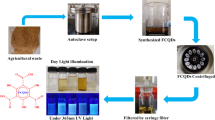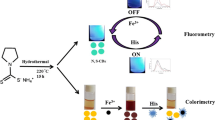Abstract
Soy flour-derived carbon quantum dots (C-dots) were successfully synthesized via a facile one-step hydrothermal approach. The as-prepared C-dots exhibit an average diameter of 2.5 nm and the crystalline lattices are consistent with graphitic carbons. Meanwhile, they show strong photoluminescence (quantum yield is 7.85 %), good water solubility, and high photostability. Importantly, structural defects of the C-dots were designed to obtain controllable fluorescence, which was achieved by changing the contents of N defects and O defects of C-dots. Our results indicate that N defects can more effectively enhance the fluorescence emission than O defects. As the preparation temperature increases, the N defects are fine-tuned by substituting for partial O defects, reducing nonradiative recombination and enhancing fluorescence intensity, which is further confirmed by surface passivation. Due to its fine photostability, high sensitivity, and good selectivity for Fe3+, the as-prepared C-dots were used as fluorescence probes for detection of ferric ion. The detection limitation comes to 0.021 µM.









Similar content being viewed by others
References
Arundithi A, Wang X, Parimal R, Barindra S, Sierin L, Dong Hwan K, Kok Hwa L, Li J, Chen P (2014) Facile synthesis of graphene quantum dots from 3D graphene and their application for Fe3+ Sensing. Adv Funct Mater 24(20):3021–3026. doi:10.1002/adfm.201303441
Bai W, Zheng H, Long Y, Mao X, Gao M, Zhang L (2011) A carbon dots-based fluorescence turn-on method for DNA Determination. Anal Sci 27(3):243. doi:10.2116/analsci.27.243
Baker SN, Baker GA (2010) Lumineszierende Kohlenstoff-Nanopunkte: Nanolichtquellen mit Zukunft. Angewandte Chemie 122(38):6876–6896. doi:10.1002/ange.200906623
Bao L, Zhang Z-L, Tian Z-Q, Zhang L, Liu C, Lin Y, Qi B, Pang D-W (2011) Electrochemical tuning of luminescent carbon nanodots: from preparation to luminescence mechanism. Adv Mater 23(48):5801–5806. doi:10.1002/adma.201102866
Bourlinos AB, Stassinopoulos A, Anglos D, Zboril R, Karakassides M, Giannelis EP (2008) Surface functionalized carbogenic quantum dots. Small 4(4):455–458. doi:10.1002/smll.200700578
Cao L, Sahu S, Anilkumar P, Bunker CE, Xu J, Fernando KAS, Wang P, Guliants EA, Tackett KN, Sun Y-P (2011) Carbon nanoparticles as visible-light photocatalysts for efficient CO2 conversion and beyond. J Am Chem Soc 133(13):4754–4757. doi:10.1021/ja200804h
De B, Karak N (2013) A green and facile approach for the synthesis of water soluble fluorescent carbon dots from banana juice. Rsc Adv 3(22):8286–8290. doi:10.1039/C3RA00088E
Dong L, ChongWu X Zeng, Mu L, Xue SF, Tao Z, Zhang JX (2010) The synthesis of a rhodamine B schiff-base chemosensor and recognition properties for Fe3+ in neutral ethanol aqueous solution. Sens Actuators B Chem 145(1):433–437. doi:10.1016/j.snb.2009.12.057
Dong Y, Li G, Zhou N, Wang R, Chi Y, Chen G (2012) Graphene quantum dot as a green and facile sensor for free chlorine in drinking water. Anal Chem 84(19):8378–8382. doi:10.1021/ac301945z
Fan Z, Li Y, Li X, Fan L, Zhou S, Fang D, Yang S (2014) Surrounding media sensitive photoluminescence of boron-doped graphene quantum dots for highly fluorescent dyed crystals, chemical sensing and bioimaging. Carbon 70:149–156. doi:10.1016/j.carbon.2013.12.085
Fang Y, Guo S, Li D, Zhu C, Ren W, Dong S, Wang E (2012) Easy synthesis and imaging applications of cross-linked green fluorescent hollow carbon nanoparticles. ACS Nano 6(1):400–409. doi:10.1021/nn2046373
Feng Y, Zhao J, Yan X, Tang F, Xue Q (2014) Enhancement in the fluorescence of graphene quantum dots by hydrazine hydrate reduction. Carbon 66:334–339. doi:10.1016/j.carbon.2013.09.008
Guo X, Wang C-F, Yu Z-Y, Chen L, Chen S (2012) Facile access to versatile fluorescent carbon dots toward light-emitting diodes. Chem Commun 48(21):2692–2694. doi:10.1039/C2CC17769B
Hu Y, Yang J, Tian J, Jia L, Yu J-S (2014) Waste frying oil as a precursor for one-step synthesis of sulfur-doped carbon dots with pH-sensitive photoluminescence. Carbon 77:775–782. doi:10.1016/j.carbon.2014.05.081
Jeong J, Cho M, Lim YT, Song NW, Chung BH (2009) Synthesis and Characterization of a Photoluminescent Nanoparticle Based on Fullerene-Silica Hybridization. Angewandte Chemie 48(29):5296–5299. doi:10.1002/anie.200901750
Jiang J, He Y, Li S, Cui H (2012) Amino acids as the source for producing carbon nanodots: microwave assisted one-step synthesis, intrinsic photoluminescence property and intense chemiluminescence enhancement. Chem Commun 48(77):9634–9636. doi:10.1039/C2CC34612E
Jung J, Solanki A, Memoli KA, K-i Kamei H, Kim MA Drahl, Williams LJ, Tseng H-R, Lee K (2010) Selective inhibition of human brain tumor cells through multifunctional quantum-dot-based siRNA delivery. Angewandte Chemie 122(1):107–111. doi:10.1002/ange.200905126
Lee TS, Yang C, Park WH (2000) Synthesis and electrostatic multilayer assembly of an acridine-containing polymer with properties of an optical sensor. Macromol Rapid Commun 21(14):951–955. doi:10.1002/1521-3927(20000901)21:14<951:AID-MARC951>3.0.CO;2-N
Li N, Xu Q, Xia X, Wang L, Lu J, Wen X (2009) A polymeric chemosensor for Fe3+ based on fluorescence quenching of polymer with quinoline derivative in the side chain. Mater Chem Phys 114(1):339–343. doi:10.1016/j.matchemphys.2008.09.027
Li H, He X, Kang Z, Huang H, Liu Y, Liu J, Lian S, Tsang CHA, Yang X, Lee S-T (2010) Water-soluble fluorescent carbon quantum dots and photocatalyst design. Angewandte Chemie 49(26):4430–4434. doi:10.1002/anie.200906154
Li H, Kang Z, Liu Y, Lee S-T (2012) Carbon nanodots: synthesis, properties and applications. J Mater Chem 22(46):24230–24253. doi:10.1039/C2JM34690G
Li X, Zhang S, Kulinich SA, Liu Y, Zeng H (2014) Engineering surface states of carbon dots to achieve controllable luminescence for solid-luminescent composites and sensitive Be2+ detection. Sci Rep 4(2):4976–4984. doi:10.1038/srep04976
Liu Y, Wu P (2013) Graphene quantum dot hybrids as efficient metal-free electrocatalyst for the oxygen reduction reaction. ACS Appl Mater Interfaces 5(8):3362–3369. doi:10.1021/am400415t
Liu R, Wu D, Liu S, Koynov K, Knoll W, Li Q (2009) An aqueous route to multicolor photoluminescent carbon dots using silica spheres as carriers. Angewandte Chemie 121(25):4668–4671. doi:10.1002/ange.200900652
Liu S, Tian J, Wang L, Zhang Y, Qin X, Luo Y, Asiri AM, Al-Youbi AO, Sun X (2012) Hydrothermal treatment of grass: a low-cost, green route to nitrogen-doped, carbon-rich, photoluminescent polymer nanodots as an effective fluorescent sensing platform for label-free detection of Cu(II) ions. Adv Mater 24(15):2037–2041. doi:10.1002/adma.201200164
Loh KP, Bao Q, Eda G, Chhowalla M (2010) Graphene oxide as a chemically tunable platform for optical applications. Nat Chem 2(12):1015–1024. doi:10.1038/nchem.907
Lu W, Qin X, Liu S, Chang G, Zhang Y, Luo Y, Asiri AM, Al-Youbi AO, Sun X (2012) Economical, green synthesis of fluorescent carbon nanoparticles and their use as probes for sensitive and selective detection of mercury(II) ions. Anal Chem 84(12):5351–5357. doi:10.1021/ac3007939
Mei Q, Zhang K, Guan G, Liu B, Wang S, Zhang Z (2010) Highly efficient photoluminescent graphene oxide with tunable surface properties. Chem Commun 46(39):7319–7321. doi:10.1039/c0cc02374d
Nie H, Li M, Li Q, Liang S, Tan Y, Sheng L, Shi W, Zhang SX-A (2014) Carbon dots with continuously tunable full-color emission and their application in ratiometric ph sensing. Chem Mater 26(10):3104–3112. doi:10.1021/cm5003669
Peng H, Travas-Sejdic J (2009) Simple aqueous solution route to luminescent carbogenic dots from carbohydrates. Chem Mater 21(23):5563–5565. doi:10.1021/cm901593y
Qu Q, Zhu A, Shao X, Shi G, Tian Y (2012) Development of a carbon quantum dots-based fluorescent Cu2+ probe suitable for living cell imaging. Chem Commun 48(44):5473–5475. doi:10.1039/C2CC31000G
Sahu S, Behera B, Maiti TK, Mohapatra S (2012) Simple one-step synthesis of highly luminescent carbon dots from orange juice: application as excellent bio-imaging agents. Chem Commun 48(70):8835–8837. doi:10.1039/C2CC33796G
Seung Lee T, Yang C, Kim JL, Lee J-K, Park WH, Won Y (2002) Synthesis of polyquinoline ether and its optical sensor property in the presence of metal cations. J Polym Sci Part A Polym Chem 40(11):1831–1837. doi:10.1002/pola.10270
Sun Y-P, Zhou B, Lin Y, Wang W, Fernando KAS, Pathak P, Meziani MJ, Harruff BA, Wang X, Wang H, Luo PG, Yang H, Kose ME, Chen B, Veca LM, Xie S-Y (2006) Quantum-sized carbon dots for bright and colorful photoluminescence. J Am Chem Soc 128(24):7756–7757. doi:10.1021/ja062677d
Sun W, Du Y, Wang Y (2010) Study on fluorescence properties of carbogenic nanoparticles and their application for the determination of ferrous succinate. J Lumin 130(8):1463–1469. doi:10.1016/j.jlumin.2010.03.013
Sun D, Ban R, Zhang PH, Wu GH, Zhang JR, Zhu JJ (2013a) Hair fiber as a precursor for synthesizing of sulfur- and nitrogen-co-doped carbon dots with tunable luminescence properties. Carbon 64:424–434. doi:10.1016/j.carbon.2013.07.095
Sun H, Gao N, Wu L, Ren J, Wei W, Qu X (2013b) Highly photoluminescent amino-functionalized graphene quantum dots used for sensing copper ions. Chemistry 19(40):13362–13368. doi:10.1002/chem.201302268
Wang F, Pang S, Wang L, Li Q, Kreiter M, Liu C-y (2010a) One-step synthesis of highly luminescent carbon dots in noncoordinating solvents. Chem Mater 22(16):4528–4530. doi:10.1021/cm101350u
Wang X, Cao L, Yang S-T, Lu F, Meziani MJ, Tian L, Sun KW, Bloodgood MA, Sun Y-P (2010b) Bandgap-like strong fluorescence in functionalized carbon nanoparticles. Angewandte Chemie 122(31):5438–5442. doi:10.1002/ange.201000982
Wu ZL, Zhang P, Gao MX, Liu CF, Wang W, Leng F, Huang CZ (2013) One-pot hydrothermal synthesis of highly luminescent nitrogen-doped amphoteric carbon dots for bioimaging from Bombyx mori silk–natural proteins. J Mater Chem Β 1(22):2868–2873. doi:10.1039/C3TB20418A
Wu M, Wang Y, Wu W, Hu C, Wang X, Zheng J, Li Z, Jiang B, Qiu J (2014) Preparation of functionalized water-soluble photoluminescent carbon quantum dots from petroleum coke. Carbon 78:480–489. doi:10.1016/j.carbon.2014.07.029
Wu W, Zhan L, Fan W, Song J, Li X, Li Z, Wang R, Zhang J, Zheng J, Wu M (2015) Cu–N dopants boost electron transfer and photooxidation reactions of carbon dots. Angewandte Chemie 127(22):6640–6644. doi:10.1002/anie.201501912
Xu Q, Liu Y, Gao C, Wei J, Zhou H, Chen Y, Dong C, Sreeprasad TS, Li N, Xia Z (2015) Synthesis, mechanistic investigation, and application of photoluminescent sulfur and nitrogen co-doped carbon dots. J Mater Chem C 3(38):9885–9893. doi:10.1039/C5TC01912E
Yang Z-C, Li X, Wang J (2011) Intrinsically fluorescent nitrogen-containing carbon nanoparticles synthesized by a hydrothermal process. Carbon 49(15):5207–5212. doi:10.1016/j.carbon.2011.07.038
Yang Z, Xu MH, Liu Y, He FJ, Gao F, Su YJ, Wei H, Zhang YF (2014) Nitrogen-doped, carbon-rich, highly photoluminescent carbon dots from ammonium citrate. Nanoscale 6(3):1890–1895. doi:10.1039/c3nr05380f
Zhang M, Bai L, Shang W, Xie W, Ma H, Fu Y, Fang D, Sun H, Fan L, Han M, Liu C, Yang S (2012) Facile synthesis of water-soluble, highly fluorescent graphene quantum dots as a robust biological label for stem cells. J Mater Chem 22(15):7461–7467. doi:10.1039/C2JM16835A
Zheng L, Chi Y, Dong Y, Lin J, Wang B (2009) Electrochemiluminescence of water-soluble carbon nanocrystals released electrochemically from graphite. J Am Chem Soc 131(13):4564–4565. doi:10.1021/ja809073f
Zhou J, Booker C, Li R, Zhou X, Sham T-K, Sun X, Ding Z (2007) An electrochemical avenue to blue luminescent nanocrystals from multiwalled carbon nanotubes (MWCNTs). J Am Chem Soc 129(4):744–745. doi:10.1021/ja0669070
Zhou L, Lin Y, Huang Z, Ren J, Qu X (2012) Carbon nanodots as fluorescence probes for rapid, sensitive, and label-free detection of Hg2+ and biothiols in complex matrices. Chem Commun 48(8):1147–1149. doi:10.1039/C2CC16791C
Zhu H, Wang X, Li Y, Wang Z, Yang F, Yang X (2009) Microwave synthesis of fluorescent carbon nanoparticles with electrochemiluminescence properties. Chem Commun 34:5118–5120. doi:10.1039/B907612C
Zhu C, Zhai J, Dong S (2012a) Bifunctional fluorescent carbon nanodots: green synthesis via soy milk and application as metal-free electrocatalysts for oxygen reduction. Chem Commun 48(75):9367–9369. doi:10.1039/C2CC33844K
Zhu S, Zhang J, Tang S, Qiao C, Wang L, Wang H, Liu X, Li B, Li Y, Yu W, Wang X, Sun H, Yang B (2012b) Surface chemistry routes to modulate the photoluminescence of graphene quantum dots: from fluorescence mechanism to up-conversion bioimaging applications. Adv Funt Mater 22(22):4732–4740. doi:10.1002/adfm.201201499
Zhuo S, Shao M, Lee S-T (2012) Upconversion and downconversion fluorescent graphene quantum dots: ultrasonic preparation and photocatalysis. ACS Nano 6(2):1059–1064. doi:10.1021/nn2040395
Acknowledgments
This work is financially supported by the National Natural Science Foundation of China (Grant No. 21376268) and the Fundamental Research Funds for the Central Universities (No. 15CX08005A).
Author information
Authors and Affiliations
Corresponding authors
Electronic supplementary material
Below is the link to the electronic supplementary material.
Rights and permissions
About this article
Cite this article
Fang, L., Xu, Q., Zheng, X. et al. Soy flour-derived carbon dots: facile preparation, fluorescence enhancement, and sensitive Fe3+ detection. J Nanopart Res 18, 224 (2016). https://doi.org/10.1007/s11051-016-3521-z
Received:
Accepted:
Published:
DOI: https://doi.org/10.1007/s11051-016-3521-z




